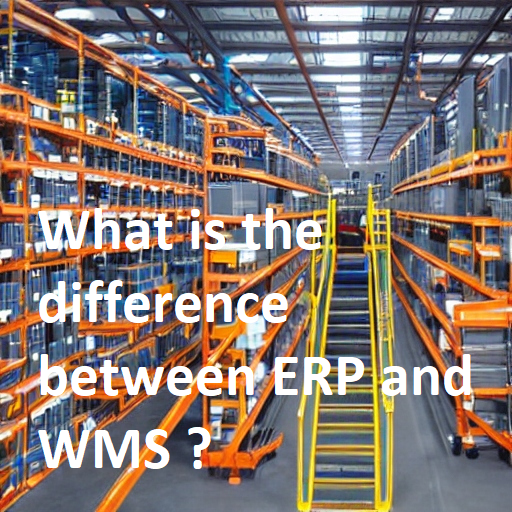What is the difference between ERP and WMS ?
ERP (Enterprise Resource Planning) and WMS (Warehouse Management System) are both software solutions used in businesses, but they have different functions and applications.
ERP is a system that integrates and manages all of the core business processes and data of an organization, including finance, human resources, manufacturing, supply chain, and customer relationship management. It provides a centralized database that enables various departments to access and share information, improving communication and collaboration between different business functions.
On the other hand, WMS (Warehouse Management System) is a system that focuses on managing the storage and movement of goods within a warehouse. It provides tools for tracking inventory levels, organizing warehouse layouts, and optimizing order fulfillment processes. A WMS (Warehouse Management System) helps businesses to increase warehouse efficiency, reduce costs, and improve accuracy and timeliness of order deliveries.
In summary, while ERP systems are designed to manage the overall business processes, WMS (Warehouse Management System) systems are more specific to managing the logistics of the warehouse. ERP systems may include WMS (Warehouse Management System) modules as part of their suite of functionalities, but they typically provide broader support for the enterprise as a whole.
Some of the key features of an ERP system include:
-
Integration: An ERP system integrates different business functions into a single system, making it easier to manage the entire organization.
-
Automation: ERP systems automate many routine tasks, such as data entry and reporting, reducing manual effort and errors.
-
Analytics: ERP systems provide a wealth of data that can be used to track performance, identify opportunities for improvement, and make informed decisions.
-
Scalability: ERP systems are designed to grow with the organization, supporting its needs as it expands.
On the other hand, a WMS (Warehouse Management System) is a specialized system that focuses on managing the storage and movement of goods within a warehouse. It provides tools for tracking inventory levels, organizing warehouse layouts, and optimizing order fulfillment processes. A WMS (Warehouse Management System) helps businesses to increase warehouse efficiency, reduce costs, and improve accuracy and timeliness of order deliveries.
Some of the key features of a WMS (Warehouse Management System) include:
-
Inventory management: A WMS provides real-time inventory tracking, helping businesses to maintain accurate inventory levels and reduce overstocks and stockouts.
-
Warehouse organization: A WMS (Warehouse Management System) helps to organize warehouse layouts, making it easier to locate items and optimize storage space.
-
Order fulfillment: A WMS (Warehouse Management System) helps to streamline order fulfillment processes, reducing errors and increasing order accuracy and timeliness.
-
Real-time data: A WMS (Warehouse Management System) provides real-time data on warehouse operations, helping managers to make informed decisions and optimize processes.
While there is some overlap between the functionality of ERP and WMS (Warehouse Management System), they are designed to serve different purposes. An ERP system provides a comprehensive solution for managing the overall operations of an enterprise, while a WMS (Warehouse Management System) is designed to manage the specific logistics of a warehouse. Many businesses choose to integrate both ERP and WMS (Warehouse Management System) to manage their operations, taking advantage of the strengths of each system to improve overall efficiency and profitability.
An ERP system is designed to manage the overall operations of an enterprise, integrating various functions such as finance, accounting, HR, sales, marketing, supply chain, and manufacturing. It provides a central database that allows different departments to access and share information, providing a holistic view of the organization’s operations. An ERP system provides real-time information, which helps decision-makers to make informed decisions, optimize business processes, and improve overall efficiency.
Some of the key features of an ERP system include:
-
Integration: An ERP system integrates different business functions into a single system, making it easier to manage the entire organization.
-
Automation: ERP systems automate many routine tasks, such as data entry and reporting, reducing manual effort and errors.
-
Analytics: ERP systems provide a wealth of data that can be used to track performance, identify opportunities for improvement, and make informed decisions.
-
Scalability: ERP systems are designed to grow with the organization, supporting its needs as it expands.
On the other hand, a WMS (Warehouse Management System) is a specialized system that focuses on managing the storage and movement of goods within a warehouse. It provides tools for tracking inventory levels, organizing warehouse layouts, and optimizing order fulfillment processes. A WMS helps businesses to increase warehouse efficiency, reduce costs, and improve accuracy and timeliness of order deliveries.
Some of the key features of a WMS (Warehouse Management System) include:
-
Inventory management: A WMS (Warehouse Management System) provides real-time inventory tracking, helping businesses to maintain accurate inventory levels and reduce overstocks and stockouts.
-
Warehouse organization: A WMS (Warehouse Management System) helps to organize warehouse layouts, making it easier to locate items and optimize storage space.
-
Order fulfillment: A WMS (Warehouse Management System) helps to streamline order fulfillment processes, reducing errors and increasing order accuracy and timeliness.
-
Real-time data: A WMS (Warehouse Management System) provides real-time data on warehouse operations, helping managers to make informed decisions and optimize processes.
While there is some overlap between the functionality of ERP and WMS(Warehouse Management System), they are designed to serve different purposes. An ERP system provides a comprehensive solution for managing the overall operations of an enterprise, while a WMS (Warehouse Management System) is designed to manage the specific logistics of a warehouse. Many businesses choose to integrate both ERP and WMS (Warehouse Management System) to manage their operations, taking advantage of the strengths of each system to improve overall efficiency and profitability.

